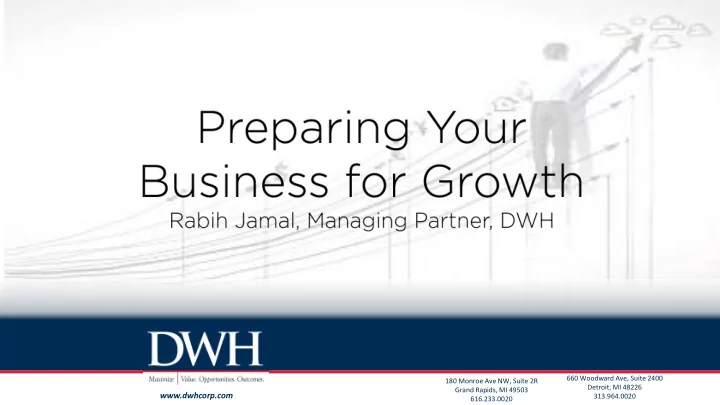

660 Woodward Ave, Suite 2400 180 Monroe Ave NW, Suite 2R Detroit, MI 48226 Grand Rapids, MI 49503 www.dwhcorp.com 313.964.0020 616.233.0020
Operational excellence secures the present. Innovation excellence secures the future. - Roger Milliken
Five Stages of Business Growth A company’s developmental stage determines the factors it will face as well as the actions required to prepare for any changes or challenges in the business’s future. Owners must anticipate and manage the changes needed to transition from one stage to the next. Source: Churchill & Lewis: The Five Stages of Small Business Growth, Harvard Business Review
Five Stages of Growth Existence: In the first stage of a business, the owner is trying to establish a presence in the market they are serving, identify a customer base and deliver a product. At this stage the owner is responsible for every aspect of the business and performs all the tasks including providing the necessary capital. Survival: At this stage, the business is an established entity with recurring revenues and expenses and cash sufficient to stay in business. The organization is simple with a limited number of employees. A general manager may exist but major decisions are still determined by the ownership and planning is limited. Success: The enterprise has grown in size and profitability and ownership is facing a decision whether to remain stable and profitable at current levels or invest in growth strategies. At this stage, a business has achieved economic health, has sufficient size and product-market penetration to ensure economic success but is being managed for profit and not for growth. Assuming no change in external factors; the business could stay at this stage indefinitely. However, in order to make the leap to the next stage extensive strategic planning is required. The planning addresses protecting the core business and the main source of cash, hiring leaders/managers with an eye to the future, improving systems and creating detailed plans for all aspects of the business (Marketing and Sales, Operations, and Finance and Information). Take Off: This is a pivotal stage in a company’s growth both financially and managerially. The financial demands are greater due to inv estments in new initiatives (new products, new locations, new management, and new systems). The ownership is heavily involved in continuous strategic and operational planning with the involvement of key management but is delegating the responsibility of execution to those managers. An effective management team can handle the added complexity of the business if ownership is willing to allow mistakes to be made while monitoring the business through performance controls and Key Performance Indicators (“KPI’s”). Resource Maturity: A company at this stage has a substantial organization with an engaged managerial team that is experienced and uses detailed strategic plans, budgets and systems to manage the business. The ownership is separate from the business and the company has achieved a critical mass that provides it certain advantages in the market (size, financial resources and managerial talent).
Value Creation and Growth • What does growth mean for your business? • Are you growing for the right reasons? • Can your business sustain growth? • Does growth maximize cash flow? Investment Balance Sheet
Organizational Foundation Job Descriptions (Roles, Responsibility, Accountability of Individual) Action Organization Economic Plans Chart Analysis (To Do Lists – Match (Hierarchy, (Forecasts & Budgets) Strategic Objectives) Interfaces of Group) Strategies (Strategy Statements that Define Direction) Values (Defined Management Principals)
Primary Areas for Considerations People Property Process • Cost Management • Facilities • Operations Leadership • Inventory Management • Equipment • Strategy • Quality Systems • IP • Organization • Procurement & Sourcing • Maintenance • Competency • Logistics • Capital Expenditures • Capacity • LEAN • Resource Utilization • Morale • Disciplines/Controls (KPI’s) • Resource Utilization • Material Flow • Transaction Processing Cycles
Cash Flow Forecasting Improvements and efficiencies gained along with the timeliness and accuracy of information critical for financial management and decisions related to growth: • Capitalization and financing terms negotiations • Customer pricing and terms negotiations • Timely invoicing and payables entry • Vendor cost and terms negotiations • Capital expenditures and related financing • Expense visibility and control • Improved revenue forecasting • Variance analysis 13-week Rolling Cash Flow Model 12-24 Month Forecast • Validate and provide confidence that the company’s • Predict short- and near-term cash position (relative to business model is creating economic value collateral) • Improve communication with the business’ economic • Aid management in its short- and near-term decision stakeholders (internal and external) making related to cash and collateral • Improve communication with the business’ economic stakeholders (internal and external)
Prepare Your Business for Growth Four Key Categories of Thinking to Consider Selecting and Testing Current Leadership Tribal/Institutional Knowledge • Need time to test and adjust, if necessary • Key Performance Indicators • Processes that drive value • Direction (vision) • Communication (aligning stakeholder interests) – Sales & marketing – Operations • Implementation (tactical) • From Tribal to Institutional – Best practices Key Relationship Transition – Documentation • Relationships are critical to creating and sustaining – Training economic value • Must ensure knowledge extends beyond leader • Internal and External – Key Stakeholder groups Financial Systems & Controls o Owners/Investors o Customers • Going from low-leverage to high-leverage o Communities o Suppliers • Considerations o Employees – Management experience and competence/capabilities – Others o Advisors – Bank covenants and other compliance – Cash and collateral forecasting o Bank(s) – Timely, accurate, and relevant financial and o Family non-financial information
Recommend
More recommend